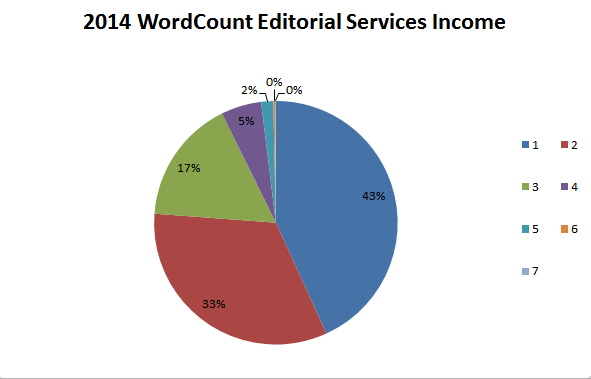Interesting trends in my freelance writing business for 2014. I’ve started to use the term editorial services business because it does a better job of describing what I do –read on and you’ll see why.
That’s a lot of bosses!
In 2014, I got paid by 18 clients, including newspapers, consumer and business magazines, online-only publications, content marketing agencies, a national member organization and several corporate clients. The top 9 accounted for 99% of my income. The balance of my income came from reprint fees, a kill fee (my one and only was for a project that got pulled after the client decided not to update a whitepaper) and blog ad revenue of less than $200.
My biggest client accounted for 30% of my income, and three others accounted for 15% to 20%. Hooray for anchor clients.
Of my top 9 clients, 5 were new – but not out-of-the blue new. In one case, a content marketing agency I’d worked with before brought me into a project for a new client. In another, I’d known the publication’s editor for years though this was the first time she hired me. In another, the client contacted me based on work I did in 2013 for a related organization.
Long-time clients, I love you
Last year marked my 8th year writing for one client, and the 5th year I did editing and project management for another. I’ve been doing content marketing work longer than that phrase has been around to describe it: it was my 5th year working with one content marketing agency, and 3rd year working with another.
My income from long-term clients changes dramatically from year to year. But I’ve got enough of them now that when assignments from one dry up due to freelance budget constraints, regime changes, etc., I can make up the difference by pitching more work for another.
The ‘D’ word
In the past few years, I’ve expanded from writing to doing that plus editing and editorial project management. I crunched the numbers to see how much of my income came from each source. Here’s what I found — it pays to diversify, literally.
In 2014, writing represented a substantial chunk of my income, 43% on the pie chart I shared above.
I broke down my writing income further to see where it came from:
- Close to half (46%) came from a gig I got early in the year writing tech-heavy research reports for a national consumer organization.
- Almost a third (29%) came from a newspaper column I write twice a month.
- 24% came from writing reported feature stories for several consumer and business publications.
Of all the writing work I did last year, a very small number – 3 or 4 stories – came from ideas I pitched. The balance came from standing gigs, or editors who came to me. I’m the no pitch freelancer!
Be in charge – it pays better
My other major income sources in 2014:
Half my income came from editing (33%) and project management (17%). I lump the two together because last year, the bulk of the contract editing jobs I had included project management. I use that term to describe anything related to an editing project that’s not editing: hiring and training writers, crafting story ideas, creating editorial calendars, scheduling conference calls with clients, managing graphic designers or other contributors, etc.
A lot of tasks involved in project management are things you might not think to charge for, or might underestimate the time they take to do. But if you include them and adequately account for the time, look how much it can add to your income!
Writing, editing and project management accounted for 93% of my income. The rest came from social media management (5%) — I wrote tweets for a big tech company for a couple months — reprints (2%) and kill fees and blog ad revenue (<1%).
I still need to compare 2014 data with data from previous years to see if revenue by income sources has changed much. My hunch is writing accounted for more of last year’s income because I made a concerted effort to do more of it.
It’s clear that having a dozen-plus clients and diversifying into writing, editing and project work is working for me.
Next up: expenses.

I agree. I think diversification is more important than we want to believe. Being special at that one thing or two just isn’t enough anymore.